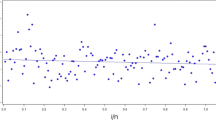Abstract
A key role in inference is played by randomization, which has been extensively used in clinical trials designs. Randomization is primarily intended to prevent the source of bias in treatment allocation by producing comparable groups. In the frequentist framework of inference, randomization allows also for the use of probability theory to express the likelihood of chance as a source for the difference of end outcome. In the Bayesian framework, its role is more nuanced. The Bayesian analysis of clinical trials can afford a valid rationale for selective controls, pointing out a more limited role for randomization than it is generally accorded. This paper is aimed to offer a view of randomization from the perspective of both frequentist and Bayesian statistics and discussing the role of randomization also in theoretical decision models.
Similar content being viewed by others
References
Altman DG, Schulz KF, Moher D, Egger M, Davidoff F, Elbourne D, Gøtzsche PC, Lang T, the CONSORT Group (2001) The revised CONSORT statement for reporting randomised trials: explanation and elaboration. Ann Intern Med 134:663–694
Bartlett RH, Roloff DW, Cornell RG, Andrews AF, Dillon PW, Zwischenberger JB (1985) Extracorporeal circulation in neonatal respiratory failure: a prospective randomized study. Pediatrics 76(4):479–487
Berger VW (2000) Pros and cons of permutation tests in clinical trials. Stat Med 19(10):1319–1328
Berry SM, Kadane JB (1997) Optimal Bayesian randomization. J R Stat Soc 59(4):813–819
Berry SM, Bradley P, Carlin J, Lee JJ, Muller P (2010) Bayesian adaptive methods for clinical trials, Chapman & Hall, Boca Raton
Biswas S, Liu DD, Lee JJ, Berry DA (2009) Bayesian clinical trials at the University of Texas M. D. Anderson Cancer Center. Clin Trials 6(3):205–216
Brown AR, Gajewski BJ, Aaronson LS et al (2016) A Bayesian comparative effectiveness trial in action: developing a platform for multisite study adaptive randomization. Trials 17(1):428
Christen JA, Muller P, Wathen K, Wolf J (2004) Bayesian randomized clinical trials: a decision-theoretic sequential design. Can J Stat 32(4):387–402
Cox DR (2009) Randomization in the design of experiments. Int Stat Rev 77:415–429
Cumberland WG, Royall RM (1988) Does simple random sampling provide adequate balance? J R Stat Soc 50:118–124
Efron B (1971) Forcing a sequential experiment to be balanced. Biometrika 58(3):403–417
Fisher RA (1935) The design of experiments. Oliver and Boyd, Edinburgh
Gelman A (2008) Rejoinder. Bayesian Anal 3(3):467–478
Gelman A, Carlin J, Stern H, Dunson D, Vehtari A, Rubin D (2014) Bayesian data analysis, 3rd Edition, Chapman and Hall/CRC, Boca Raton
Hacking I (1988) Telepathy: origins of randomization in experimental design. Isis 79:427–451
Hall NS (2007) RA Fisher and his advocacy of randomization. J Hist Biol 40(2):295–325
Hey SP, Truog RD (2015) The question of clinical equipoise and patients’ best interests. AMA J Ethics 17(12):1108–1115
Holland PW (1986) Statistics and causal inference. J Am Stat Assoc 81(396):945–960
Jiang F, Lee JJ, Muller P (2013) A Bayesian decision-theoretic sequential response-adaptive randomization design. Stat Med 32(12):1975–1994
Lachin JM (1988) Statistical properties of randomization in clinical trials. Control Clin Trials 9(4):289–311
Lee JJ, Chu CT (2012) Bayesian clinical trials in action. Stat Med 31(25):2955–2972
Lee JJ, Chen N, Yin G (2012) Worth adapting? Revisiting the usefulness of outcome-adaptive randomization. Clin Cancer Res 18(17):4498–4507
Lin Y, Zhu M, Su Z (2015) The pursuit of balance: an overview of covariate-adaptive randomization techniques in clinical trials. Contemp Clin Trials 45(Pt A):21–25
Little RJ (2006) Calibrated Bayes. Am Stat 60(3):213–223
Medical Research Council (1948) STREPTOMYCIN treatment of pulmonary tuberculosis. Br Med J 2(4582): 769–782
Rosenberger WF (2010) The agile approach to adaptive research. Wiley, New Jersey
Rosenberger WF, Lachin JM (1993) The use of response-adaptive designs in clinical trials. Control Clin Trials 14(6):471–484
Rosenberger WF, Lachin JM (2016) Randomization in clinical trials: theory and practice. Wiley, New York
Rosenberger WF, Stallard N, Ivanova A, Harper CN, Ricks ML (2001) Optimal adaptive designs for binary response trials. Biometrics 57(3):909–913
Rosner AL (2012) Evidence-based medicine: revisiting the pyramid of priorities. J Bodyw Mov Ther 16(1):42–49
Rubin DB (1978) Bayesian inference for causal effects: the role of randomization. Ann Stat 6(1):34–58
Rubin DB (1991) Practical implications of modes of statistical inference for causal effects and the critical role of the assignment mechanism. Biometrics 47(4):1213–1234
Sackett DL, Rosenberg WM, Gray JA, Haynes RB, Richardson WS (1996) Evidence based medicine: what it is and what it isn’t. BMJ 312(7023):71–72
Savage LJ (1962) Subjective probability and statistical practice. In: Savage LJ et al (ed) The foundations of statistical inference. Methuen, London
Saxman SB (2015) Ethical considerations for outcome-adaptive trial designs: a clinical researcher’s perspective. Bioethics 29(2):59–65
Spiegelhalter D, Abrams K, Myles J (2004) Bayesian approaches to clinical trials and health care evaluation. Wiley, Chichester
Thall PF, Wathen JK (2007) Practical Bayesian adaptive randomisation in clinical trials. Eur J Cancer 43(5):859–866
Urbach P (1993) The value of randomization and control in clinical trials. Stat Med 12(15–16):1421–1431. (discussion 1433–1441)
Wei IJ, Durham S (1978) The randomized play-the-winner rule in medical trials. J Am Stat Assoc 73:840–843
Worrall J (2007) Why there’s no cause to randomize. Br J Philos Sci 58(3):451–488
Acknowledgements
This research was supported by the University of Torino, Grant No. BERP_RILO_17_01.
Author information
Authors and Affiliations
Corresponding author
Rights and permissions
About this article
Cite this article
Berchialla, P., Gregori, D. & Baldi, I. The Role of Randomization in Bayesian and Frequentist Design of Clinical Trial. Topoi 38, 469–475 (2019). https://doi.org/10.1007/s11245-018-9542-8
Published:
Issue Date:
DOI: https://doi.org/10.1007/s11245-018-9542-8




